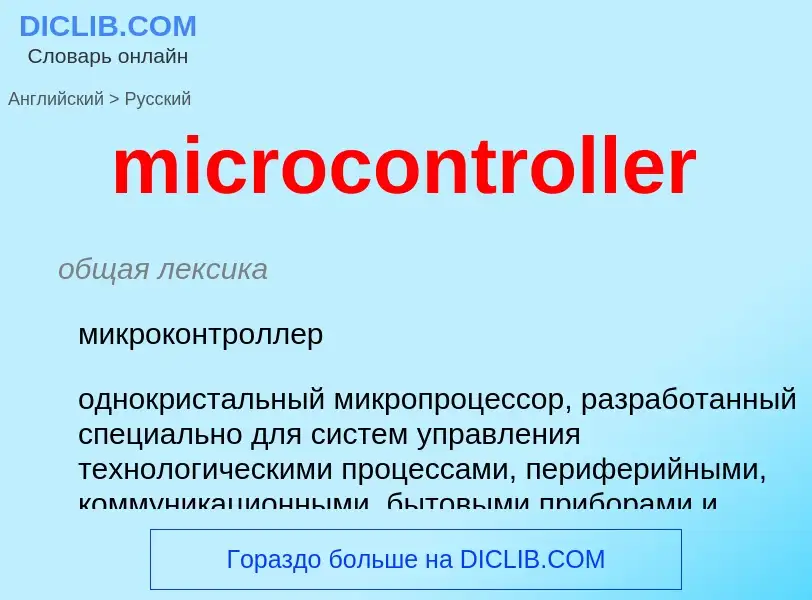Tradução e análise de palavras por inteligência artificial ChatGPT
Nesta página você pode obter uma análise detalhada de uma palavra ou frase, produzida usando a melhor tecnologia de inteligência artificial até o momento:
- como a palavra é usada
- frequência de uso
- é usado com mais frequência na fala oral ou escrita
- opções de tradução de palavras
- exemplos de uso (várias frases com tradução)
- etimologia
microcontroller - tradução para russo
общая лексика
микроконтроллер
однокристальный микропроцессор, разработанный специально для систем управления технологическими процессами, периферийными, коммуникационными, бытовыми приборами и другими устройствами. Обычно имеет небольшой объём ОЗУ, ППЗУ/ПЗУ и порты ввода-вывода
Смотрите также
общая лексика
автомобильный микроконтроллер, микроконтроллер для автомашин
Смотрите также
математика
четырехразрядный
Definição
Wikipédia

A microcontroller (MCU for microcontroller unit, also MC, UC, or μC) is a small computer on a single VLSI integrated circuit (IC) chip. A microcontroller contains one or more CPUs (processor cores) along with memory and programmable input/output peripherals. Program memory in the form of ferroelectric RAM, NOR flash or OTP ROM is also often included on chip, as well as a small amount of RAM. Microcontrollers are designed for embedded applications, in contrast to the microprocessors used in personal computers or other general purpose applications consisting of various discrete chips.
In modern terminology, a microcontroller is similar to, but less sophisticated than, a system on a chip (SoC). An SoC may connect the external microcontroller chips as the motherboard components, but an SoC usually integrates the advanced peripherals like graphics processing unit (GPU) and Wi-Fi interface controller as its internal microcontroller unit circuits.
Microcontrollers are used in automatically controlled products and devices, such as automobile engine control systems, implantable medical devices, remote controls, office machines, appliances, power tools, toys and other embedded systems. By reducing the size and cost compared to a design that uses a separate microprocessor, memory, and input/output devices, microcontrollers make it economical to digitally control even more devices and processes. Mixed signal microcontrollers are common, integrating analog components needed to control non-digital electronic systems. In the context of the internet of things, microcontrollers are an economical and popular means of data collection, sensing and actuating the physical world as edge devices.
Some microcontrollers may use four-bit words and operate at frequencies as low as 4 kHz for low power consumption (single-digit milliwatts or microwatts). They generally have the ability to retain functionality while waiting for an event such as a button press or other interrupt; power consumption while sleeping (CPU clock and most peripherals off) may be just nanowatts, making many of them well suited for long lasting battery applications. Other microcontrollers may serve performance-critical roles, where they may need to act more like a digital signal processor (DSP), with higher clock speeds and power consumption.


![Infrared remote control PCB - an [[infrared remote control]] transmitter controlled by a NEC D63GS 4-bit microcontroller Infrared remote control PCB - an [[infrared remote control]] transmitter controlled by a NEC D63GS 4-bit microcontroller](https://commons.wikimedia.org/wiki/Special:FilePath/Alps remote control BHR970001B-7517.jpg?width=200)
![20-pin PSOP - NEC D63GS: a 4-bit microcontroller for [[infrared remote control]] transmission 20-pin PSOP - NEC D63GS: a 4-bit microcontroller for [[infrared remote control]] transmission](https://commons.wikimedia.org/wiki/Special:FilePath/Alps remote control BHR970001B - NEC D63GS-7525.jpg?width=200)

![Olympia CD700 Desktop Calculator using the National Semiconductor MAPS MM570X [[bit-serial]] 4-bit microcontroller Olympia CD700 Desktop Calculator using the National Semiconductor MAPS MM570X [[bit-serial]] 4-bit microcontroller](https://commons.wikimedia.org/wiki/Special:FilePath/Olympia CD700 Desktop Calculator. 1971.Microprogrammable Arithmetic Processor System Devices (MAPS).jpg?width=200)
